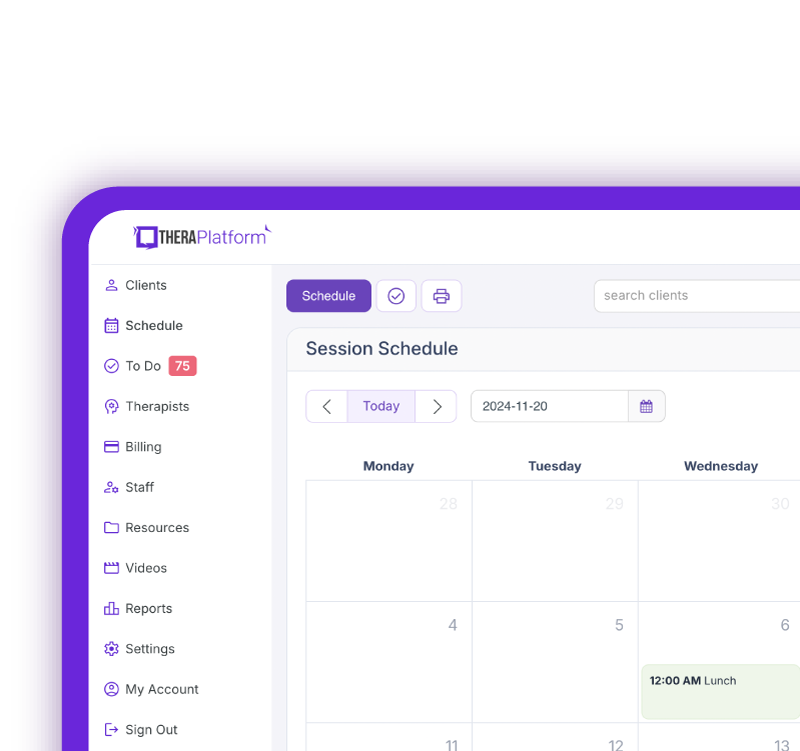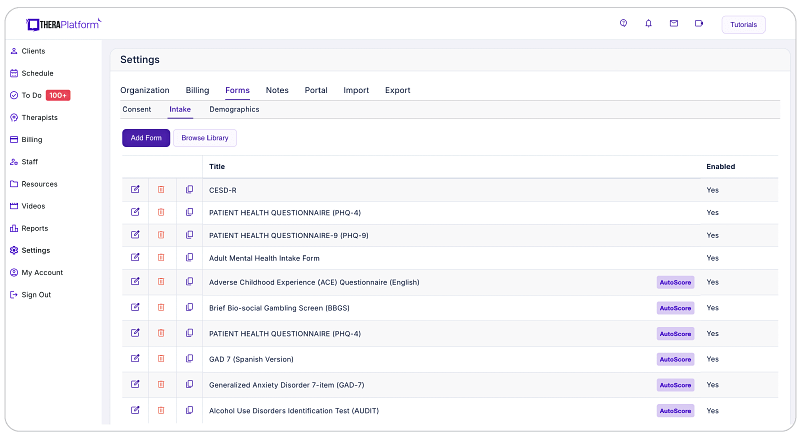Intake process

The intake process gives you the opportunity to begin the therapeutic relationship and develop a connection with your client. Developing an accurate, easy intake process is a great way to set a firm foundation for the therapeutic process. In this blog, you’ll learn how to establish an effective intake process that helps you and your client.
Summary
- Initial intake sessions help determine client-therapist fit and build trust, offering a safe space to assess goals, explain services, and address financial and logistical details like insurance, payment, and session format.
- Clear communication about your intake process and data handling—including what’s collected, how it’s stored, and client privacy — sets the stage for a smooth therapeutic relationship and supports compliance. Download my free privacy policy notice.
- Waitlists are becoming a standard intake tool due to increased demand since COVID, allowing therapists to manage overflow while keeping prospective clients engaged via newsletters or social media.
- Using HIPAA-compliant tools like TheraPlatform can streamline client onboarding, automate admin tasks, and securely manage intake data — saving time and supporting practice growth.
Streamline your practice with One EHR
- Scheduling
- Flexible notes
- Template library
- Billing & payments
- Insurance claims
- Client portal
- Telehealth
- E-fax

Now the phone is starting to ring and your email inbox is filling up with inquiries. How do you best capture contact and client information in a way that suits your business and clinical needs AND feels comfortable and safe for your clients? Initial sessions as part of the intake process are a more traditional method while wait lists, a trend spurred in part by COVID, are rapidly becoming a more common part of the intake process.
Intake process steps
Initial sessions and determining fit
The first step in the intake process is scheduling potential clients for an initial session gives you and the client an opportunity to determine if the relationship is a good fit and is a regular part of intake counseling. Offering a free, brief intake session can encourage a client to reach out to you and removes some of the financial concerns and risks clients may feel with regard to seeing a private practice therapist.
While most intake session requests come in through word of mouth or online forms or Contact Us links and emails on websites, practice management tools offer other avenues like public schedulers. With these schedulers, you can embed an interactive calendar on your site that syncs to your calendar so visitors can directly schedule an intake session with you based on your availability.
When clients reach out to you, they likely feel pain and feel vulnerability. If they’ve never had counseling before, they might not even know what to say when they reach out to you as a private practice therapist. Your goal with this initial session is to guide them safely and comfortably through your intake process. You want the client to recognize that you are someone to trust who can help with the pain. You want to provide hope.
Practice Management + EHR + Telehealth
Manage more in less time in your practice with TheraPlatform

What to say in the intake session
During the intake session, discover why this person reached out to you for help. Use your assessment skills to determine:
- Can you help this client? Do you have the training, experience, and skills to appropriately address the issue(s)?
- Do you want to work with this client? Resentment may build if you’re working with a client that isn’t a good fit and this may make you a less effective private practice therapist.
- If you cannot help this client or do not want to help this client, then offer referrals to another provider.
Use the intake session as a time to explain your intake processes and begin orientation to your therapeutic style and approach:
- Do you offer in office or telehealth sessions? Do you provide specialized services such as EMDR, play therapy, or meditation?
- What is the length of sessions and frequency of sessions?
The next component in determining if this client is a good fit for your practice is discussing fees. Knowing whether a client can pay is important.
Third position: Free Resources for Therapists
It’s helpful to explain:
- Are you a private pay?
- Do you take insurance, and if so which insurance?
- If you are private pay, do you offer a sliding scale?
During the intake process, you may also want to explain to the client what information you’ll need (ie., email address) and what to expect in terms of paperwork before scheduling that first session. Managing expectations around data and privacy is another way to build trust with the client.
Taking time to explain this during the intake process can increase the likelihood of the client completing the paperwork without you having to ask for it again. It can also prevent delays of the first session due to lack of compliance with paperwork.
What to say and do before the first counseling intake session
Once the intake process is complete and you’ve decided to move forward with an initial counseling session, it’s time to onboard the client and collect the information needed to build your chart and initiate services. Because you have taken the time to build rapport during an intake session, your client should feel more comfortable sharing important information with you.
And from the perspective of a private practice therapist, knowing upfront how you'll handle client data will save you a lot of time and set your business up for success.
Consider these questions as part of your intake process:
- What type of data do you want to collect from clients as part of intake counseling? Is it email, phone number, credit card, etc. (e.g., having a valid form of payment on file, for example, makes it accessible for any copayment charges, no-show fees, or other fees that may accrue. Explain this in your policy and emphasize in paperwork how the payment information is stored.)
- How do you want to collect intake counseling data? (Does the client enter information on a paper form and will the information be manually entered? Do you prefer a digital option?)
- Where will you store client data once you have it? (Do you prefer file cabinets or is a client portal more important to you? Is your method of storage HIPAA compliant?)
- How will you manage intake counseling data? (Do you need to review data regularly? Will data need to be retained for a certain amount of time or purged periodically?)
- Who will manage it? Most first-time private practice therapists manage their own data but a few outsource.
Knowing your intake processes upfront and how you can easily collect, organize and maintain all your client information in a safe and HIPAA-compliant manner will save you a ton of time later as your practice grows.
Another tip before that first session is to ensure that you have the correct contact information for the client. You want to have the appropriate email address and telephone number to forward your intake packet, and set up your appointment reminder system.
Watch this video to discover TheraPlatform’s EHR benefits for your practice
Improving intake forms with EHR software
EHR software and practice management tools, such as TheraPlatform, offer numerous advantages in creating accurate, efficient, and organized forms. Therapists can send digital intake forms and outcome measures electronically via secure client portal.
Benefits of using EHR for notes management
Manually writing and storing forms can be cumbersome for clients and therapists. That process can be further exacerbated by simple document requests that include locating, faxing or scanning documents.
Features like customizable forms, secure storage, easy sharing, duplication, electronic signatures, and efax integration, streamline the form process, optimizing therapy administration and workflows.
Consistent forms with template library: EHRs equipped with a library of form templates ensures consistency across forms, making it easier to access and complete forms. Additionally, EHRs provide centralized storage and management of forms, enhancing accessibility and organization.

Screenshot of TheraPlatform built-in library of forms
Save time with automatically scored outcome measures
Mental health therapists can use outcome measures to document progress, track a variety of key clinical indicators, helping providers make data-driven decisions, improve communication with clients, and improve client outcomes. Additionally, outcome measures help therapists adhere to compliance requirements and provide documentation needed to support reimbursement.
While outcome measures clearly provide benefits to both clients and therapists, they can be time-consuming, especially if clinicians score responses manually.
However, many aspects of outcome measures can be automated through an EHR like TheraPlatform:
- Sending measurements: Common assessments can be automatically sent to clients and stored in their records or they can be scheduled on regular intervals.
- Auto scoring: TheraPlatfrom automatically scores and sums totals for common outcome measures.
- Report building and analysis: Results can be analyzed over time, with visual charts showing progress on rates of severity and session-to-session progress.
By regularly using these measures, therapists can gain valuable insights, tailor interventions, and improve client outcomes while demonstrating the effectiveness of their care without manual entry.

Do I need a waitlist for intake counseling?
A new trend has arisen since the onset of COVID in which more and more people are reaching out for counseling services and private practice therapists. It created a situation in which many private practice therapists have a full caseload and no room on their calendars to schedule new clients. For this reason, it may be helpful to develop a waitlist for intake counseling. This waitlist gives clients some hope of getting help and gives you a ready-made referral bank to use when you have an opening.
Most practice management systems have an outlet available to create your waitlist. If you have a newsletter, blog, or other email list, you can add the clients on your waitlist to this service to keep them engaged and connected to you. You can also encourage them to follow any social media platforms that you utilize. Waitlists typically need to be visited weekly to stay current as part of intake counseling. Establish intake processes for how and when you’ll assess your wait list.
Safely capturing your client information and communicating how it will be used is a critical part of intake counseling and the therapeutic relationship. It allows for the opportunity to begin building rapport, developing the trust needed in therapy, and helps with client retention.
Streamline your practice with One EHR
- Scheduling
- Flexible notes
- Template library
- Billing & payments
- Insurance claims
- Client portal
- Telehealth
- E-fax

Resources
Theraplatform is an all-in-one EHR, practice management and teletherapy solution that allows you to focus more on patient care. With a 30-day free trial, you have the opportunity to experience Theraplatform for yourself with no credit card required. Cancel anytime. They also support different industries including mental and behavioral health therapists in group practices and solo practices.
More resources
- Identifying your ideal client
- Intake form follows function
- Therapy resources and worksheets
- Therapy private practice courses
- Ultimate teletherapy ebook
- The Ultimate Insurance Billing Guide for Therapists
- The Ultimate Guide to Starting a Private Therapy Practice
Free video classes
- Free mini video lessons to enhance your private practice
- 9 Admin tasks to automate in your private practice
FAQs about the intake process
What is the purpose of an intake session in therapy?
An intake session helps determine whether the therapist and client are a good fit, establishes rapport, clarifies goals and expectations, and reviews key logistics such as session format, fees, and insurance details.
What information is typically collected during the intake process?
Therapists may collect basic contact information, medical and mental health history, payment details, consent forms, and scheduling preferences. This data must be stored securely and in compliance with HIPAA standards.
Do therapists need a waitlist as part of their intake process?
Many therapists use waitlists due to high demand, allowing potential clients to hold a spot while staying engaged through newsletters or updates. Practice management platforms like TheraPlatform can automate and organize waitlists efficiently.



